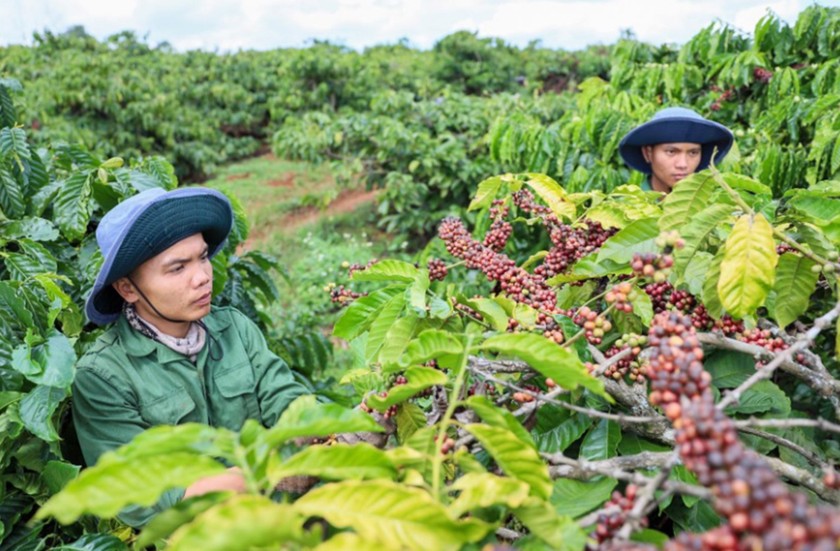According to economists, Vietnam’s exports of agriculture, forestry and fishery have low value because the country has sold raw materials.

Vietnam’s exports of agriculture, forestry and fishery have low value
Vietnam’s agricultural, forestry and fishery exports have continuously grown over the past 10 years. Many items such as coffee, rubber, rice, vegetables, cashews, shrimp, and wooden furniture brought revenues of over US$1 billion, but the growth is mainly thanks to the increase in scale and output; many products are still exported raw, especially coffee.
Vietnam export agricultural raw materials at cheap price
According to the Ministry of Agriculture and Rural Development, the country currently grows about 710,000ha of coffee, mainly in the Central Highlands region. Every year, Vietnam’s coffee output and export turnover are very large; for example, it exported over 1.78 million tons in 2022, reaching a turnover of more than US$4 billion exceeding the export revenue of rice.
However, according to Mr. Thai Nhu Hiep, Vice Chairman of the Vietnam Coffee and Cocoa Association, the rate of export of deep-processed coffee is very low, Vietnamese enterprises mainly export raw materials to foreign partners. For instance, more than half of coffee planting areas in Gia Lai Province, where there are about 99,000 hectares of coffee, have switched to growing according to 4C Code of Conduct which means reducing pesticide use, and environmental protection to produce organic and high-quality agricultural products.
According to Mr. Doan Ngoc Co, Deputy Director of the Department of Agriculture and Rural Development of Gia Lai Province, the province has about 80 coffee-processing facilities so the province can export about 5 percent-6 percent of processed coffee while the rest is raw.
Dak Nong Province with nearly 140,000ha of coffee is facing the same situation.
Chairman of the Vietnam – International Business Connection Club Dinh Vinh Cuong said that Vietnam is the world’s second-largest coffee exporter just after Brazil but very few businesses build a brand name for the coffee industry to help Vietnamese coffee rank in the top 10 most expensive coffee brands in the world. Many experts also believe that making a lot of raw exports is a big disadvantage for Vietnamese businesses, especially coffee growers because the agricultural produce is sold at low prices not achieving the expected profit. Specifically, the selling price is only about $2,400 a ton if Vietnam sells green coffee, while the average selling price of 1 ton of processed coffee is up to $3,600 not to mention the higher shipping costs of green coffee.
Inadequate value
Former Minister of Agriculture and Rural Development Nguyen Xuan Cuong said that out of 10 percent of Vietnam’s deep-processing coffee products such as roasting, powder, and instant, it is mainly sold in the domestic market while the remaining 90 percent of raw coffee output is for export, which can even become raw materials of many countries for deep processing and re-export to Vietnam for consumption.
The paradox is that while Vietnam exports raw without branded coffee, many businesses are importing processed coffee and Vietnamese consumers are paying for each cup of coffee for $2-$3 equivalent to 1-2 kg of coffee that businesses buy from farmers in the form of raw materials. Obviously, overseas businesses are benefiting greatly from Vietnamese agricultural products thanks to investment in deep processing technology.
From the above-mentioned paradox of agricultural products, Mr. Dinh Vinh Cuong said that businesses should no longer export raw materials but need to invest in deep processing according to international standards. Simultaneously, they should focus on building brand names, protection and investment in clean production to increase value and meet the requirements of fastidious and potential markets.
Former Minister of Agriculture and Rural Development Nguyen Xuan Cuong also said that every year the world spends about $500 billion on coffee consumption, Vietnam is supplying about 19 percent of the world’s output, but revenue from coffee exports coffee each year only reaches $3.5 billion-$4 billion showing that the trade value is too small compared to the export output. The world has only 9 million tons, but Vietnam’s exports in 2022 are 1.7 million tons.
Talking about the value and brand of Vietnamese coffee, Minister of Agriculture and Rural Development Le Minh Hoan said that whenever he goes abroad, he always brings Vietnamese coffee to use because the quality is much better than coffee from other countries. Minister Le Minh Hoan agreed with the solution to promote deep processing to increase export value.
Former Minister of Agriculture and Rural Development Cao Duc Phat said that in the value chain, the production stage is the lowest profitable stage but Vietnam has focused on this stage. According to European economic analysts, the value of production only accounts for about 12 percent-13 percent of the total added value of agricultural products. Thus, more than 80 percent of the remaining is in other stages, including processing, branding, and trade; therefore, Vietnam now has to pour more money in those stages.

